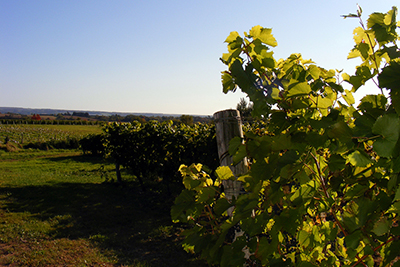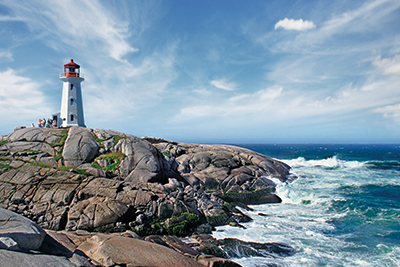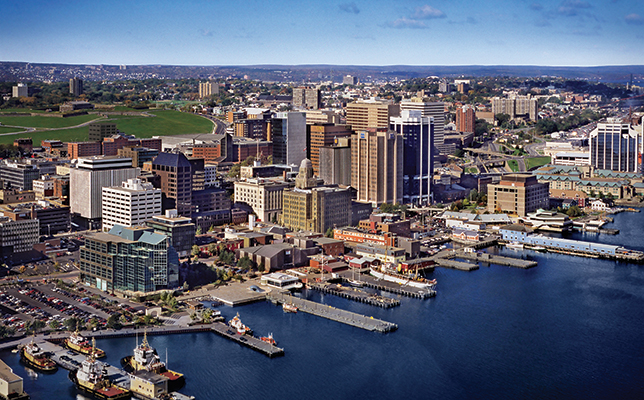
Montreal and Halifax are separated by less than 800 miles. Because of the vastly different cultures, though, they feel even farther apart than that. One is a gorgeous cosmopolitan city that could be the finest example of European sensibilities on North American soil. The other is a picturesque haven along the water that prides itself on seafaring almost as much as it does on smiling.
VIA Rail, the national passenger train service of Canada, connects the two cities with its Ocean route, a thrice-weekly, 22-hour trip that’s filled with informative guides, tasty meals and lasting memories. Couple all of the on-board excitement with everything happening outside with the passing landscape and you see why so many Montrealers make the trek. Now, before embarking on the journey yourself from Halifax to Montreal, there’s more than 48 hours of excitement waiting for you on the Maritime side of things.
Simply put, the ocean is quite the temptress. She’ll woo you with gentle breezes and hypnotic motions of the water. But get too close and she’ll bite. Nowhere is this mercurial behavior more present than in Halifax, the capital city of Nova Scotia. Situated in a basin in the North Atlantic Ocean, the area has long been a gravitating force—be it the indigenous Mi’kmaq people or the Acadians from France in the 1600s.
Many people who lived here during those times worked on the sea. Their stories are relived at the Maritime Museum of the Atlantic, a treasure trove of boating diagrams, nautical artifacts and vintage photos. The museum’s two most important exhibits, however, surround tragic events on the water: the Titanic disaster in 1912 and the infamous Halifax Explosion of 1917. Though Newfoundland was technically closer to the failed Titanic, emergency teams and other life-saving essentials came from better-prepared Nova Scotia. In fact, the largest resting place for Titanic victims is Halifax’s Fairview Lawn Cemetery.
After visiting the museum, you have a host of options: You can grab a quick bite at one of the waterfront stalls (The Shack Oyster Bar’s snow crab and lobster rolls are just the right mix of creamy and chunky) and get lost in the shops (Lost Cod Clothing Co. is a must-stop for customizable shirts with iconic Canadian brand logos); or you could make the five-minute walk over to The Five Fishermen Restaurant & Grill, a polished eatery with split personalities—there’s the traditional grandeur upstairs and its less-serious culinary cousin downstairs. Because it’ll be lunchtime when you go, you’ll have to settle for downstairs. Luckily, it features the same spoon-filling seafood chowder and Parmesan-crusted baked haddock, so you’re still in good shape. It’s also here where you can get your first lesson in Nova Scotian wine. (Tip: Start with a glass of Domaine de Grand Pré Tidal Bay, a crisp white made with 100 percent Nova Scotia-grown grapes that goes wonderfully with most any seafood.)
Let your lunch settle by taking the walking tour at the Alexander Keith’s brewery. The local beer is beloved around Eastern Canada, and its interactive tour—actors and working kilns and free Indian Pale Ale samples, oh my!—is an absolute treat.
 Keep the libations under control, though, because you’ll need to make a 45-minute drive to your next stop, Peggy’s Cove. While you would have gotten your first glimpse of sea life at the museum and along the harbor, it’s at the cove where you get an unfiltered view of what maritime life in the province is all about. A sleepy fishing village of about 650 residents, Peggy’s Cove offers Facebook-worthy snapshots near Peggy’s Point Lighthouse and thought-drifting moments on the rocky shore.
Keep the libations under control, though, because you’ll need to make a 45-minute drive to your next stop, Peggy’s Cove. While you would have gotten your first glimpse of sea life at the museum and along the harbor, it’s at the cove where you get an unfiltered view of what maritime life in the province is all about. A sleepy fishing village of about 650 residents, Peggy’s Cove offers Facebook-worthy snapshots near Peggy’s Point Lighthouse and thought-drifting moments on the rocky shore.
When you finally pull yourself away, it’s off to another unapologetically charming town called Lunenburg. It’s here where you’ll dock for the night. Like something ripped right out of a Stephen King novel—well, actually, the SyFy channel’s supernatural drama Haven is mainly filmed in Chester, about 10 minutes away—Lunenburg has everything you might expect in a city along the North Atlantic coast (churches from the 1800s, scallop-catching boats) and a few things you probably wouldn’t (Ironworks vodka distillery).
Lunenburg Arms Hotel & Spa is a historic boutique property that knows a few things about melding the old (unique hardwood furniture) with the new (lightning fast Wi-Fi). But even beyond the private quarters, the restaurant, Rissers Social House, is a find. Nova Scotia fishcakes and “fruits of the sea” (haddock, salmon, sea scallops and tiger shrimp in a light sherry-shrimp sauce over pasta) couldn’t be much fresher—even if the chef snuck out the back, ran across the street and snatched the seafood off a boat himself.
If the dinner (and glass of locally produced Blomidon L’Acadie Blanc) hasn’t taken its toll on your body, complete your night with a walking ghost tour from seventh-generation Lunenburg native Shelah Allen. A giddy storyteller, Allen insists, “Lunenburg has more ghosts per capita than any other town in Canada.”
Day Two
Let’s hope nightmares didn’t ruin your rest because you have an hour-and-a-half drive toward Annapolis Valley. The aforementioned Acadians settled in an area called Grand-Pré in the late 1600s, becoming skilled farmers and living relatively harmoniously with the native Mi’kmaq. In the 1700s, British soldiers stormed in and terrorized anyone who wasn’t for their cause. (Some Acadians who were deported went as far south as Louisiana, thus becoming “Cajun.”) The Grand-Pré National Historic Site, a UNESCO World Heritage Site, recounts these times through a fascinating 3-D presentation and lovingly landscaped grounds.
After that emotional experience, it’ll be time for lunch. Only about 40 minutes from Grand-Pré is another postcard-perfect fishing village called Hall’s Harbour. The Hall’s Harbour Lobster Pound restaurant is kitschy (the gift shop sells lobster socks), kooky (you pick out your lobster and literally take it to the cook in a tray) and quite the culinary treat (juicy lobster mac ‘n’ cheese). Sadly, the eatery shut its traps for the season on Oct. 14, reopening on Mother’s Day weekend in May.
 From there, it’s time to fully experience some of the wine you’ve only sampled up to this point. The province is teeming with 22 vineyards. In fact, from Hall’s Harbour, you could go in the direction of Blomidon Estate Winery or go to Luckett Vineyards; however, the best overall experience is probably at Domaine de Grand Pré, a winery producing everything from seyval blanc to ice wine. Domaine de Grand Pré also does private lessons and maintains a restaurant, Le Caveau, that promotes a Nova Scotia menu filled with locally sourced ingredients, seafood and wild game.
From there, it’s time to fully experience some of the wine you’ve only sampled up to this point. The province is teeming with 22 vineyards. In fact, from Hall’s Harbour, you could go in the direction of Blomidon Estate Winery or go to Luckett Vineyards; however, the best overall experience is probably at Domaine de Grand Pré, a winery producing everything from seyval blanc to ice wine. Domaine de Grand Pré also does private lessons and maintains a restaurant, Le Caveau, that promotes a Nova Scotia menu filled with locally sourced ingredients, seafood and wild game.
All of the dining and driving probably have you pretty tired by now. Make your way to the cozy town of Wolfville where you will spend your second evening at the Blomidon Inn. A restored sea captain’s mansion, today the inn is a delightfully English retreat for city dwellers in need of a respite and couples longing for a romantic weekend. Whichever category you fall into, you’ll find that the staff’s hospitality warms the soul and the Victorian-inspired restaurant’s cuisine (house-smoked salmon, braised lamb shank) excites the taste buds.
When you wake the next morning, you will have one mission—make the one-hour drive from Wolfville back to Halifax in time to catch the 12:20 p.m. VIA Rail train to Montreal. If the memories collected while exploring Maritime Canada over the past 48 hours aren’t enough to fill you up for the trip, a menagerie of muffins and melons off the inn’s continental breakfast spread should do the trick.
Photos Courtesy of Mark Tyler-Nova Scotia Tourism Agency, VIA Rail and Blomidon Estate


